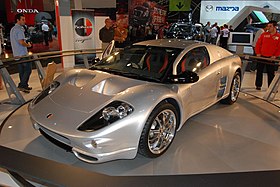Bolwell Nagari
The Bolwell Nagari is a sports car produced by Bolwell in Australia. The original Mk VIII Nagari was built from 1970 to 1974 and the Mk X Nagari was launched in 2008.
Mk VIII Nagari
| Bolwell Mk VIII Nagari | |
|---|---|
 Bolwell Mk VIII Nagari Coupe | |
| Overview | |
| Manufacturer | Bolwell |
| Production | 1970 to 1974[1] |
| Assembly | Mordialloc, Victoria |
| Body and chassis | |
| Class | Sports car |
| Body style | 2-door coupé 2-door convertible |
| Layout | FR layout |
| Powertrain | |
| Engine | 5.0L Ford Windsor 302 V8 5.8L Ford Windsor 351 V8 |
| Transmission | 4-speed manual |
| Dimensions | |
| Wheelbase | 2,350 mm (92.5 in) |
| Length | 4,013 mm (158.0 in) |
| Width | 1,676 mm (66.0 in) |
| Height | 1,118 mm (44.0 in) |
| Curb weight | 927 kg (2,044 lb) (coupé) 1,038 kg (2,288 lb) (convertible) |
| Chronology | |
| Predecessor | Bolwell Mk VII |
Nagari is an aboriginal word meaning "flowing," and the Bolwell Nagari, also known as the Mk VIII, was the company's first full production sports car with 100 coupes and 18 convertibles made.[2] It was manufactured from 1970 to 1974[3] and became the best known out of the 9 Bolwell car designs: the Mk I-VIII and Ikara. The Nagari featured a Ford 302 or 351 cubic inch V8 engine mounted in a 920 kg (2,028 lb), 2,280 mm (89.8 in) wheelbase body and backbone chassis. Other components came from Ford (suspension and dampers) and Austin 1800 (steering).
-
Mk VIII Nagari Coupe rear.
-
Mk VIII Nagari interior.
-
Mk VIII Nagari Convertible.
Motorsport
The Nagari was a popular choice of production sports car in the early ‘70s, competing in the Australian Sports Car Championship (ASCC).[4] Peter Warren won the 1975 Australian Tourist Trophy for Production Sports Cars[5] driving a Bolwell Nagari.[6]
Mk X Nagari
| Bolwell Mk X Nagari | |
|---|---|
 Bolwell Mk X Nagari | |
| Overview | |
| Manufacturer | Bolwell |
| Also called | Bolwell Nagari 300 |
| Production | 2009 to present |
| Assembly | Seaford, Victoria |
| Body and chassis | |
| Class | Sports car |
| Body style | 2-door coupé |
| Layout | MR layout |
| Powertrain | |
| Engine | 3.5L V6 3.5L V6-S |
| Transmission | 6-speed manual 6-speed automatic |
| Dimensions | |
| Wheelbase | 2,350 mm (92.5 in) |
| Length | 4,100 mm (161.4 in) |
| Width | 1,830 mm (72.0 in) |
| Height | 1,175 mm (46.3 in) |
| Curb weight | 920–990 kg (2,028–2,183 lb) |
| Chronology | |
| Predecessor | Bolwell IKARA |
In late 2006 it was announced that the Bolwell company intended to produce a new, carbon fibre-bodied car under the 'Nagari' name[7] and the model was confirmed for production in 2008.[8] The prototype debuted at the 2008 Melbourne International Motor Show and the 2008 Sydney International Motor Show. It is a mid-engined two-seater coupé with a carbon-fibre tub, front and rear subframes and a carbon-reinforced composite body. Power comes from a fettled 2GR-FE 3.5L V6 engine sourced from the Toyota Aurion, which is available either as naturally aspirated or fitted with an optional Sprintex supercharger. In N/A form the 2GR-FE produces 200–221 kW (268–296 hp) at 6200rpm, with 336–353 N⋅m (248–260 lb⋅ft) of torque at 4700rpm. Initially the Nagari was available with only a 6-speed automatic (with or without paddle shifting), however a 6-speed manual transmission was later developed. DC5-model Honda Integra tail-lights are used in the exterior. Standard features are limited, with prices starting around $150,000 AUD for a basic model, and can range up to $260,000 for a top-spec model with the supercharged engine and manual transmission.
-
Mk X Nagari rear.
-
Mk X Nagari interior.
References
- ^ Mark 8 - NAGARI at www.bolwellcarclub.com.au Retrieved on 28 June 2012
- ^ Bolwell Models Retrieved on 26 January 2010
- ^ But according to the C.A.M.S. 5th Category Historic Racing Approved Vehicle Specification sheet: Period of original manufacture is 1968/74 (Roadster 1972/74)./Bolwell%20Car%20Company%20-%20Media%20Release%20March%202008.pdf Media Release: Bolwell Nagari – From Vision to Reality Archived October 16, 2009, at the Wayback Machine Retrieved on 26 January 2010
- ^ Bolwell Nagari: Australia's Greatest Sports Car Retrieved on 18 April 2017
- ^ Production Sports Cars, Australian Competition Yearbook, 1976 Edition, pages 176-177
- ^ Past Title Winners, CAMS Manual of Motor Sport 1980, page 56
- ^ Cockington, James (23 August 2006). "Loose Change: Supercar revived". The Age. ISSN 0312-6307. Retrieved 16 November 2008.
- ^ Dillon, Pete (13 March 2008). "ABC Melbourne - Sir Jackie Stewart, Campbell Bolwell and Paul Stanley". Retrieved 16 November 2008.





